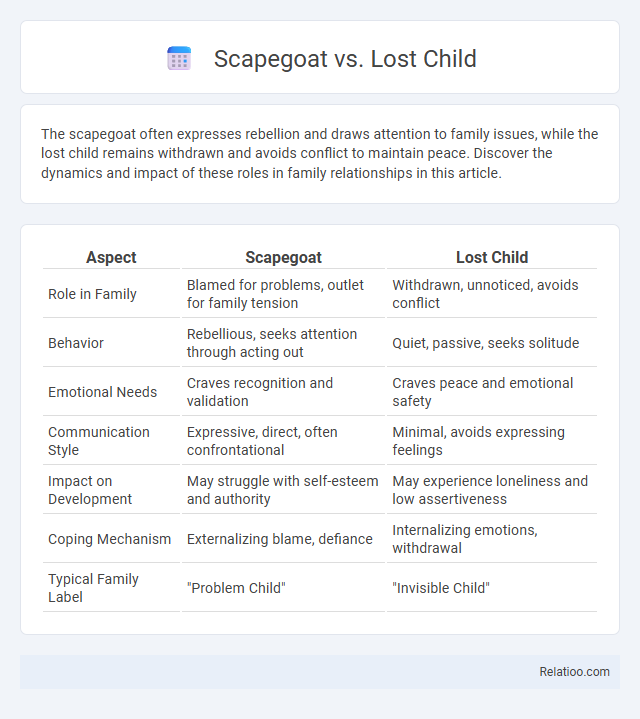The scapegoat often expresses rebellion and draws attention to family issues, while the lost child remains withdrawn and avoids conflict to maintain peace. Discover the dynamics and impact of these roles in family relationships in this article.
Table of Comparison
| Aspect | Scapegoat | Lost Child |
|---|---|---|
| Role in Family | Blamed for problems, outlet for family tension | Withdrawn, unnoticed, avoids conflict |
| Behavior | Rebellious, seeks attention through acting out | Quiet, passive, seeks solitude |
| Emotional Needs | Craves recognition and validation | Craves peace and emotional safety |
| Communication Style | Expressive, direct, often confrontational | Minimal, avoids expressing feelings |
| Impact on Development | May struggle with self-esteem and authority | May experience loneliness and low assertiveness |
| Coping Mechanism | Externalizing blame, defiance | Internalizing emotions, withdrawal |
| Typical Family Label | "Problem Child" | "Invisible Child" |
Understanding Family Roles: Scapegoat and Lost Child
Understanding family roles such as the Scapegoat and Lost Child is crucial in recognizing dysfunctional dynamics where the Scapegoat often bears blame for family conflicts, leading to externalizing behaviors, while the Lost Child tends to withdraw, avoiding attention and maintaining peace through silence. Scapegoating involves unfairly assigning blame to one individual, which can perpetuate emotional distress and hinder healthy communication patterns within the family system. You can better navigate and heal from these roles by identifying these patterns, fostering open dialogue, and seeking supportive interventions to restore balance and emotional well-being.
Defining the Scapegoat Role
The scapegoat role involves an individual being unfairly blamed for problems or conflicts within a group, often absorbing collective guilt or dysfunction. Unlike the lost child who withdraws to avoid attention, the scapegoat actively carries the burden of blame, making them a visible target for others' frustrations. Your understanding of scapegoating highlights how these roles contribute to dysfunctional family or group dynamics by assigning blame to maintain balance or avoid deeper issues.
Characteristics of the Lost Child
The Lost Child is characterized by withdrawal, quietness, and a strong desire to avoid conflict or family drama, often becoming invisible within dysfunctional family dynamics. You may notice the Lost Child seeking solace in solitude and engaging in daydreams or creative outlets to cope with feelings of neglect or emotional absence. Unlike the Scapegoat, who acts out, the Lost Child internalizes pain and avoids attention, playing a passive role in family conflicts without drawing blame or disruption.
Origins of Dysfunctional Family Patterns
Scapegoat, Lost Child, and Scapegoating roles originate from dysfunctional family patterns rooted in emotional neglect, inconsistent boundaries, and unresolved trauma. In these families, the Scapegoat is blamed to divert attention from deeper issues, while the Lost Child withdraws to avoid conflict, perpetuating cycles of maladaptive coping. Scapegoating dynamics reinforce dysfunction by maintaining imbalance through assigned roles, hindering healthy communication and emotional growth within the family system.
Scapegoat: Emotional Impact and Coping Strategies
The scapegoat in family dynamics often bears undue blame and emotional burden, leading to feelings of shame, low self-esteem, and chronic anxiety. You can cope by establishing strong personal boundaries, seeking therapy to process unresolved trauma, and building supportive relationships that validate your experiences outside the family system. Understanding the difference between scapegoat, lost child, and scapegoating patterns enhances your ability to identify toxic dynamics and promotes healthier emotional healing.
Lost Child: Emotional Consequences and Survival Tactics
The Lost Child archetype often experiences emotional neglect and feelings of invisibility, leading to deep-seated loneliness and difficulty expressing needs. To survive, Lost Children retreat into isolation, developing self-reliance and avoidance behaviors that mask their pain. This coping mechanism contrasts with the Scapegoat's outward rebellion and the broader family dynamic of Scapegoating, where blame deflects from core issues.
Comparison: Scapegoat vs Lost Child Behaviors
Scapegoat behaviors often involve acting out, seeking attention through conflict or rebellion, while Lost Child behaviors are characterized by withdrawal, silence, and avoidance to escape family drama. You may notice that Scapegoats externalize their emotions as a cry for recognition, whereas Lost Children internalize feelings, aiming to remain unnoticed. Understanding these contrasting coping mechanisms helps in identifying family roles and addressing emotional needs effectively.
Long-term Effects on Adult Relationships
Scapegoat, Lost Child, and Scapegoating roles significantly impact adult relationships by shaping emotional intimacy and trust patterns. Adults who were scapegoats often struggle with feelings of rejection and low self-worth, hindering their ability to form secure bonds, while those cast as lost children may exhibit avoidance and difficulty expressing needs, leading to emotional distance. Understanding your role in these dynamics helps break destructive cycles and fosters healthier, more authentic adult connections.
Healing and Recovery Pathways for Both Roles
Healing from roles like Scapegoat and Lost Child involves recognizing patterns of scapegoating, where blame is unfairly assigned, and addressing deep-seated emotional wounds. Your recovery pathway includes developing self-awareness, establishing healthy boundaries, and seeking therapeutic support tailored to confront guilt, shame, and feelings of invisibility. Embracing empowerment and nurturing self-compassion can transform these roles, promoting resilience and emotional balance on your healing journey.
Breaking the Cycle: Building Healthy Family Dynamics
Breaking the cycle of scapegoating and the lost child role requires fostering open communication, setting healthy boundaries, and promoting emotional validation within the family. Recognizing scapegoating patterns enables families to address underlying dysfunctions, while supporting lost children helps them develop a strong sense of identity and self-worth. Therapeutic interventions focused on understanding these dynamics facilitate healing and the creation of balanced, nurturing family relationships.

Infographic: Scapegoat vs Lost Child
 relatioo.com
relatioo.com